Rules for obtaining a rich harvest of beets: growing in the open field and care
To grow sweet and healthy beets suitable for long-term storage, you need to know the intricacies of vegetable agricultural technology. Those who master this science will be provided with a variety of vitamin dishes throughout the winter.
How to care for beets in order to grow a high-quality and rich harvest? Read about it in our article.
The content of the article
Variety selection
The choice depends on the purpose of growing the crop. Early varieties yield in spring when the body requires more vitamins.... Mid-season species are suitable for consumption during the summer season. Late varieties are stored for a long time, they are consumed in the cold months. Ideally, you should choose all three types of planting material and have a healthy vegetable all year round.
There are many varieties of beets, each with its own advantages and disadvantages. It is better to decide according to your taste. For example, Larka is a small round beet. If you prefer a disc-shaped vegetable, choose an Egyptian flat.
Important! The variety must be suitable for growing in your area.
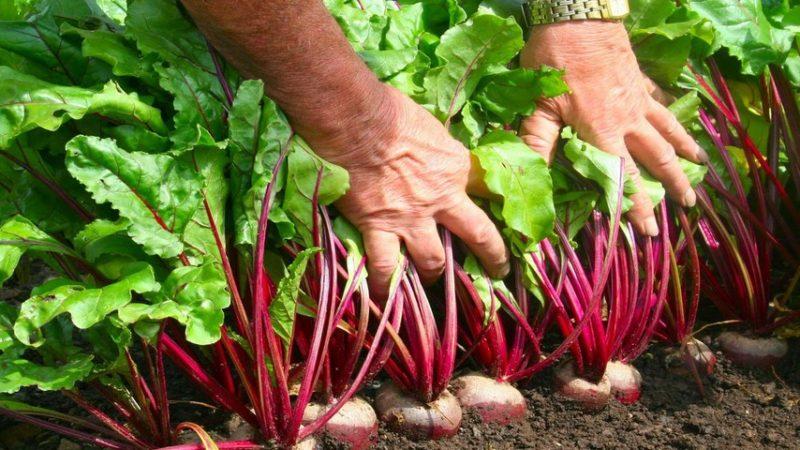
Planting and caring for beets
Beetroot is one of the most commonly used root crops. This vegetable is grown by most gardeners on their backyards. The process begins with the timing of planting and seed preparation.
When to plant beets
If the spring is warm with a daytime temperature of + 13-17 ° C and frosts are not expected, then the beets are sown when the soil warms up + 3-4 ° C. If the crop gets frozen, the root crop may turn into color and not form. Therefore, it is better not to rush with planting and wait for a stable heating of the soil to + 5-6 ° C.
Preparation of the planting area and planting germinated seeds in the ground
Organize a bed for ready-made seeds. Mark the boundaries and dig in the ground 25-30 cm deep. Break up the clods with a shovel or hoe, then loosen the soil with a rake. You can make the garden bed 10 cm above the plot level. In this case, when the soil shrinks, depressions will not form.
The distance between the rows should be 25-30 cm, between the plants - 15-20 cm. For 10 m² of soil, you will need about 15-20 g of seeds. The embedment depth depends on the soil parameters: in heavy - by 2-3 cm, in lighter - by 4 cm.
reference... For residents of the northern regions, it is better to prepare seedlings in advance. Sow the seeds into pots, then dive the ready-made seedlings into the warmed-up soil.
Planting seedlings
Beets dive into open ground in the first ten days of May, but sometimes due to weather conditions, the period is delayed almost until the end of the month. The landing site must be as sunny as possible. Before planting, seedlings and grooves are thoroughly watered. Seedlings can be transplanted with the container, if they are peat cups, without throwing out the soil in which they grew.
The beets are transplanted into ready-made holes, the depth of which will allow the root to spread freely. The distance between the holes should be at least 15 cm. After planting, the beets are watered with standing water for a week until they are completely rooted.
Thinning of beet seedlings
The more space the plant has, the larger the root crop will grow, so thinning the seedlings is a must.If the variety is multi-seeded with 3-7 shoots, this is done in several stages:
- The first thinning is done about a week later, when 2 new leaves appear at the seedlings. At this time, weak seedlings are removed from the garden. The land is well watered and the weak shoots are pulled out, leaving the strongest.
- The second thinning is performed three weeks later, when 3 leaves appear on the shoots. Plants that look weaker are pulled out.
Thinning is not done for single-sprout beet varieties. For two-seeded, only the first stage of the event is performed.
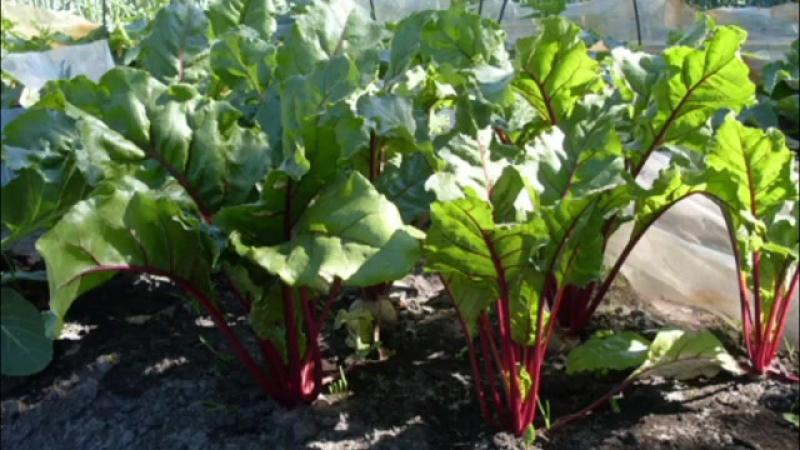
Watering and feeding
Growing and caring for beets in the open field is not difficult. For root vegetables to gain weight well, they need regular watering. Irrigation of the beds in mid-July is especially significant. During this period, the plants are poured and actively consume the supply of moisture and minerals, so you should diligently look after the beds in the midst of the summer season.
Note... If you adhere to these simple but effective rules, a bountiful beet harvest at the end of the season is ensured.
Beets tolerate changes in weather well, but are susceptible to nutrient deficiencies in the soil. Therefore, you will need to periodically feed plants with vitamin mixtures. The following compositions are used as fertilizer:
- complex mineral fertilizers;
- horse dung, bird droppings, or mullein infusion;
- decoction of nettle.
Such dressings are carried out 3 times:
- With the appearance of 2-3 leaves on beet seedlings.
- 2 weeks after the first feeding.
- At the end of July.
Diseases and pests of beets
If you loosen the soil in a timely manner, thin out the seedlings, fertilize and water regularly, the plants will already be protected from adverse factors. But sometimes this is not enough, and the beets are exposed to the invasion of pests or disease.
The likelihood of disease increases if you violated the rules of crop rotation and planted beets after cabbage or carrots. There are ways to preserve plants and get a good harvest in the future.
They start with watering crops with solutions of fungicides that destroy pathogenic fungi. In cool and humid weather, antifungal drugs are also used, otherwise the beets can be affected by downy mildew.
Attention! When preparing a bed for beets, be careful: if you add too much lime to the acidic soil, the plants will be struck by scab.
Also for beets, a beet miner fly is a considerable danger. For prophylaxis, weeds are cut out in the fall and the soil is dug up. If the fly is already feasting on the leaves, use insecticides. For early maturing varieties, chemical preparations are undesirable.... If pests appear, immediately spray the root crop with this solution: dilute 1 tbsp in 10 liters of water. l. ground black pepper and 10 g of soap. Solution consumption: 10 liters per 10 sq. m landings.
Read also:
How to recognize a beet allergy and quickly get rid of its symptoms.
The best beet jam recipes: the most delicious desserts with added fruits.
Do I need to peel beets before boiling - we will learn how to cook them.
Further cultivation and care of beets
In July-August, ash is evenly scattered under the plants (a tablespoon per 1 sq. M). Suitable mineral complexes for feeding beets: Agricola-4, Solution, Kemira-universal.
On acidic soils, with stagnant moisture and a lack of boron, fungal diseases appear in beets (peronosporosis, phomosis, fusarium rot, cercospora). If a white, grayish or purple bloom, spots, traces of rot, black dots are visible on the plants, they are treated with Bordeaux liquid or fungicides. After two weeks, they are re-processed. Those parts that are damaged are removed immediately.
Harvesting and storage of crops
Beets are harvested using a sharpened knife or shovel. Root crops are gently undermined, then removed from the soil by the tops. They clean the vegetable from the ground, cut the tops and place the crop in a dry place to dry.Do not put off trimming for a long time, as it draws nutrients from vegetables.
Experts do not recommend placing the resulting crop immediately for storage, before it is better to hold it for 1-2 days in a ventilated room at a temperature of 10-12 ° C. This is necessary to dry and tighten the resulting damage.
Note... The main thing during harvesting is to avoid damaging the surface of the vegetables and to trim the tops correctly.
Cutting the tops directly depends on the timing and methods of storing vegetables. If you store the beets until early spring, then the cuttings are left at least 2 cm long.
If stored until next season, then the tops are cut along with part of the head. This is done to prevent the vegetable from sprouting. In this case, it will take more time to heal the damage. Also, during storage, beets are periodically monitored to prevent root decay.
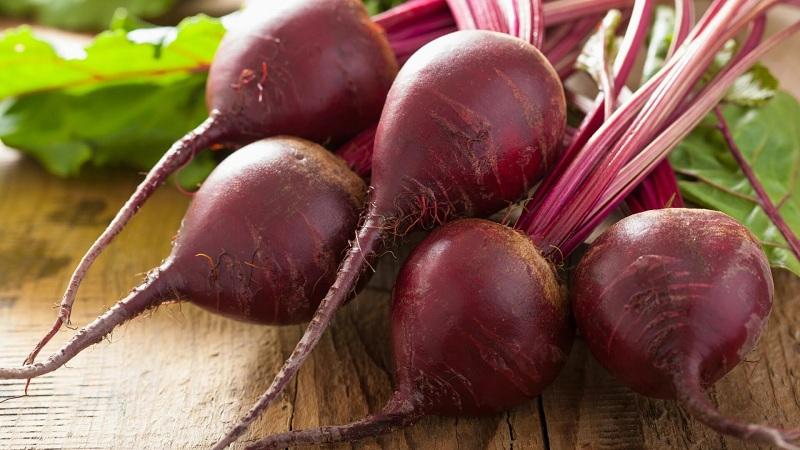
Features of care by month
In the absence of organic fertilizers, the culture is fed with mineral fertilizers. The processing scheme differs little from the introduction of organic matter.
When digging a site in May, the following is introduced into the soil:
- ammonium sulfate - 25 g;
- urea or ammonium nitrate - 20 g;
- potassium sulfate - 10-15 g;
- double superphosphate - 20 g.
If the soil contains few useful minerals, it is allowed to increase the dosage of fertilizers by 1.5 times.
After the first 3 leaves appear on the sprouts, they are fertilized with sodium nitrate.
A month later, in June, a saline solution is added. It is better to dilute the substance in green manure.
In July, ammonium nitrate (10 g) and potassium sulfate (7 g) are scattered into the grooves between the rows. After that, the soil is watered abundantly.
In the last month of summer, they are re-fed with saline. It is also allowed to process the beds with a solution of wood ash.
At the end of September, after harvesting, the soil is fertilized with phosphorus. Before digging, add double superphosphate (30 g) per 1 sq. m.
Winter landing technology
Sowing beets in spring is a common thing for most gardeners. But growing a root crop in a winter way is not so common. Farmers often make unforgivable mistakes, which causes seeds to die while still in the ground. To prevent this, it is important to know the technology.
Autumn sowing
For podzimny planting, the ridge method is more suitable (in rows filled with a slide). This ensures better soil warming in the spring and, accordingly, obtaining a very early vegetable harvest.
Subwinter sowing is performed in October-November, when a steady cooling occurs, without the return of warm days. The seed is sown on the tops of the ridges in 4-6 cm of the furrow. The grooves with seeds are sprinkled with humus earth on 2 cm, compacted and mulched on top by 3 cm for insulation.
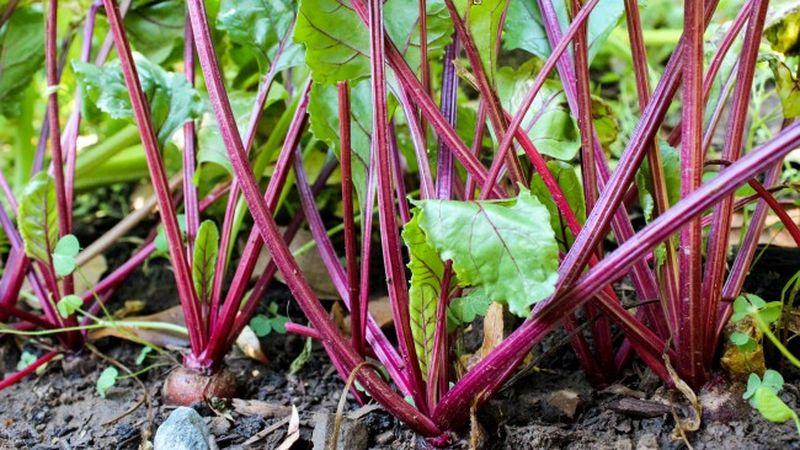
Spring sowing technology
Planting beets in the spring is carried out with dry seeds, but it is more practical to germinate them. On a flat surface, furrows are made into which the seeds are sown. Germinated seeds must be sown in moist soil. In dry soil, almost all sprouts can die.
Furrows are made at a distance of 15-25 cm. If the soil is heavy, sowing is carried out at a depth of 2 cm. If the soil is light in composition, then by 4 cm. It is impossible to deepen the crops much. The distance in the row between the seeds is 3 cm. When thinning, it is increased to 8-10 cm. This will ensure the production of standard root crops. For single-seeded sowing of beets, thinning is combined with harvesting a bunch of crops. When sowing with seed fruits, thin out 2 times.
Crop rotation rules for beets
Experienced gardeners are sure that not only plant care affects the size and quality of root crops. Beet predecessors also have a great influence. For succulent root crops, it is better to plant beets after Solanaceous plants and a number of other crops. For example, cucumbers, tomatoes, potatoes, peppers, beans, etc. Unfavorable predecessors are radishes, radishes and carrots.
Important! Growing a root crop in the same place for two years in a row is unacceptable.
Productivity with proper care
When growing beets on a large scale, the weight of vegetables and the number of root crops per hectare will depend on the harvest time. Therefore, in those farms where this crop has been successfully planted and cultivated for many years, special attention is paid to the beginning of the harvest.
Also, many novice gardeners are interested in the question, what is the yield of different types of beets from 1 hectare. After all, it is grown not only for their own needs, but also for fodder for livestock, and for sale to obtain monetary profit. So, as the experience of many farmers shows, the yield per hectare is from 40 to 50 tons of product.
Secrets of a quality harvest
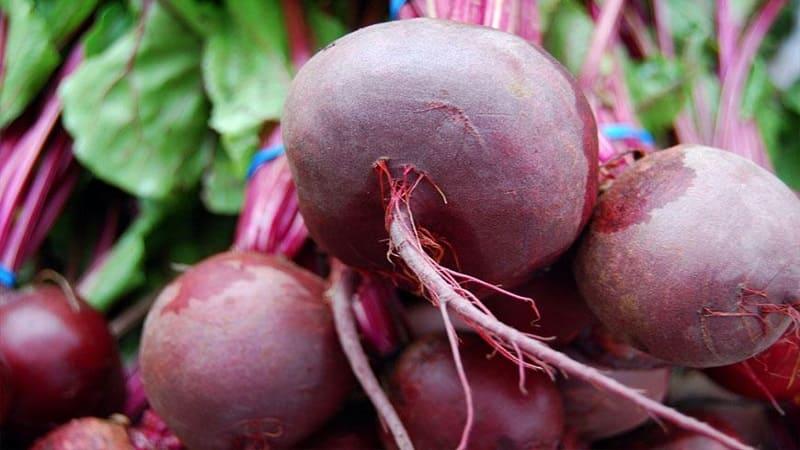
Beets need constant oxygen supply to the rhizome. It is important to ensure that the top layer of the earth does not crust over. The soil is loosened 2-3 times per season. If this is not done, the plants will need to be watered much more frequently.
To organize constant watering around the perimeter of the garden, they dig in plastic bottles with a cut-off bottom and holes on the corks with the caps down and fill them with water. The moisture is gradually absorbed into the soil and will not let the vegetable dry out. Also use a spray.
reference... If you have a tank and a narrow hose, you can make a simple drip irrigation system that will systematically provide the beets with the required amount of moisture.
Ultraviolet light contributes to the proper development of a high-quality root crop. If the beets are planted in the shade, there will be no good harvest. If at an early stage of development the crop is overgrown with weeds, the shoots will elongate, but they will be weak and may dry out completely.
Conclusion
Compliance with all the rules of agricultural technology will allow not only to get a rich harvest, but also to preserve it until next season. At the same time, the beets will be tasty and juicy.
Learn more about the intricacies of growing beets from the video: